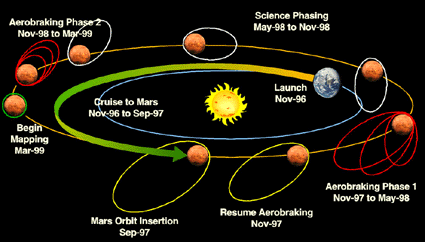This page hosted by
Last Updated: 11/16/99.
Since 01-22-98, this page has been accessed:
The NASA Mission Information Page by Jeffry
J. Brickley
This page hosted by ![]() Get your own Free Home
Page
Get your own Free Home
Page
Last Updated: 11/16/99.
Since 01-22-98, this page has been accessed: times!
Good News! NASA will be suspending the Aerobreaking manuever (see below) for scientific mission over this summer. Aerobraking is being officially discontinued on March 27. After scientists have finished calculating the current orbital path of the MGS (which will take 2-3 days), it will begin taking high resolution photos of several sites of importance. For a full write up of this story download the official press release. Once such site is the controversial "Face on Mars" in the Cydonia Mensae region of Mars. NASA claims that this is feature is natural, others claim it is proof of extra-terrestrial life... The controversy is a little much for me to get into right now, but I will be one of the first to try to download the images when they come through from the MGS! Having grown up in the state with Camel Rock and Battle Ship Rock, I'm more of the sceptic of un-natural origins, but I also like to keep an open mind! Draw your own conclusions though! NASA has a very nice write up as well as a demonstration of all of the manipulations that goes into "improving" the original images to the version that is so often seen.
UPDATE (Apr 7): I doubt if the controversy is over, but the results are certainly interesting. I know that NASA's hopes in releasing both raw and processed images was to allow others to "process" the image independantly, however, I think that the "magical" results of image processing will work to their disadvantage. I have the knowledge and software to process these images and get similar results, but most people do not. I hope that someone will (after 2 or more passes) try to produce a 3D version of the cydonia region. To see the schedule for photo passes and internet postings go to NASA press release.
UPDATE (Apr 16): Second pass of the Cydonia region (this time targetting the area known as the 'City') missed the primary target. However the images are clear enough to make out some of the erosion marks in the mountain features. Although it missed it's mark (this time), I think the MGS is still providing some excellent information on Mars and I'm looking forward to seeing the 3rd pass results of this region! Information on this region can now be found a the MGS Cydonia Region Homepage.

After it's first orbit in September, the MGS has been slowly reducing it's orbit using a process called "Aerobraking." Because of some problems with a solar panel the aerobraking must continue slower than expected. Images have started coming in and some of the discoveries are interesting, but not un-expected. The close-up views of some of the "flood-plain" looking areas shows definate signs of water errosion as well as in some of the canyons.... For live up-to-the-minute news, or a copy of some of high resolution pictures of Mars, please visit the official NASA MGS page.
Below is a live simulation (directly from NASA -- if it doesn't load I apollogize on their behalf) of where the MGS probe is. When the orbiter passes the planet Mars, you will see it come into view and the orbiter change is orientation to match. However, as you can see above, at times the orbiter is at the far edge of it's elliptical orbit and all you will see is the orbiter in space.
